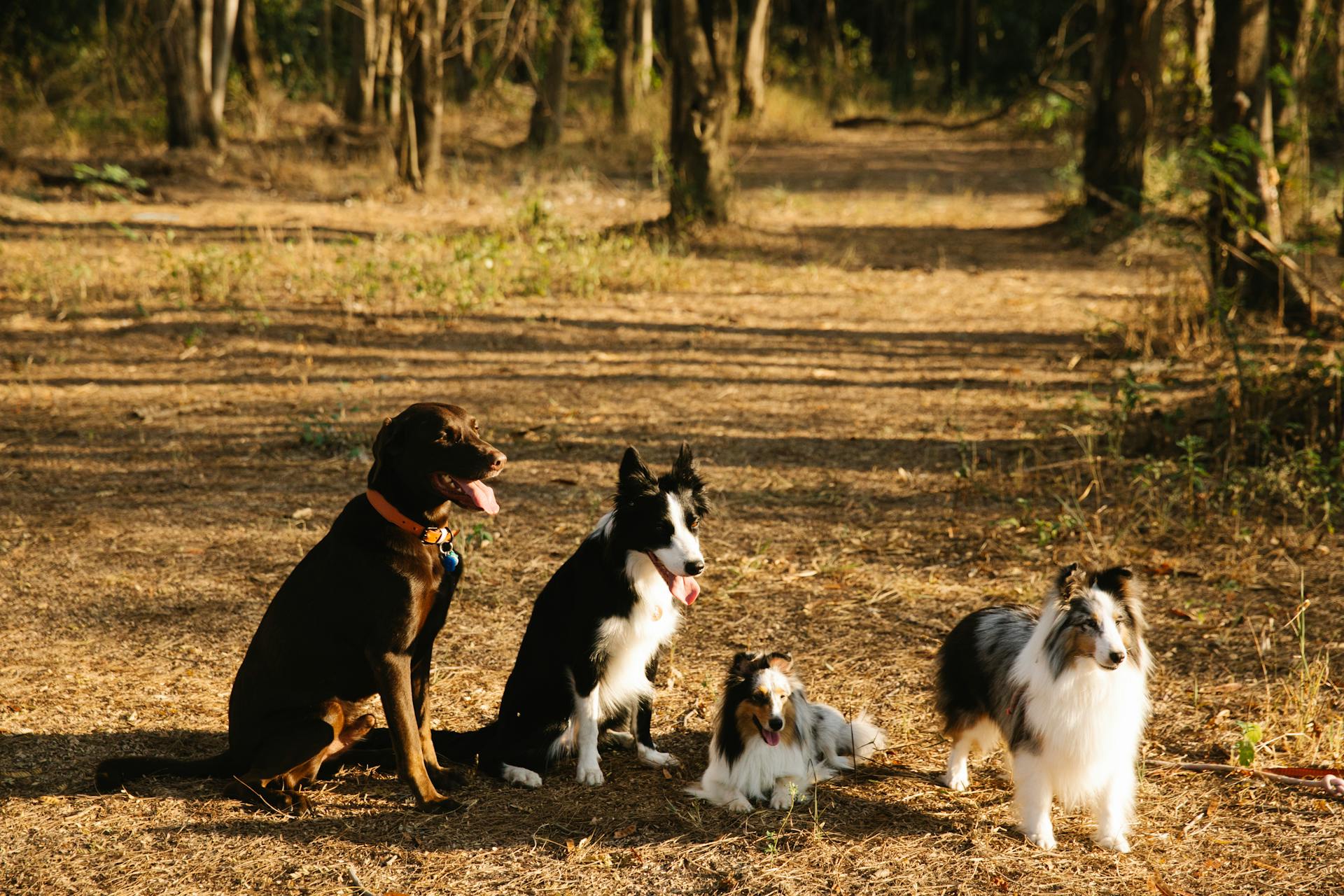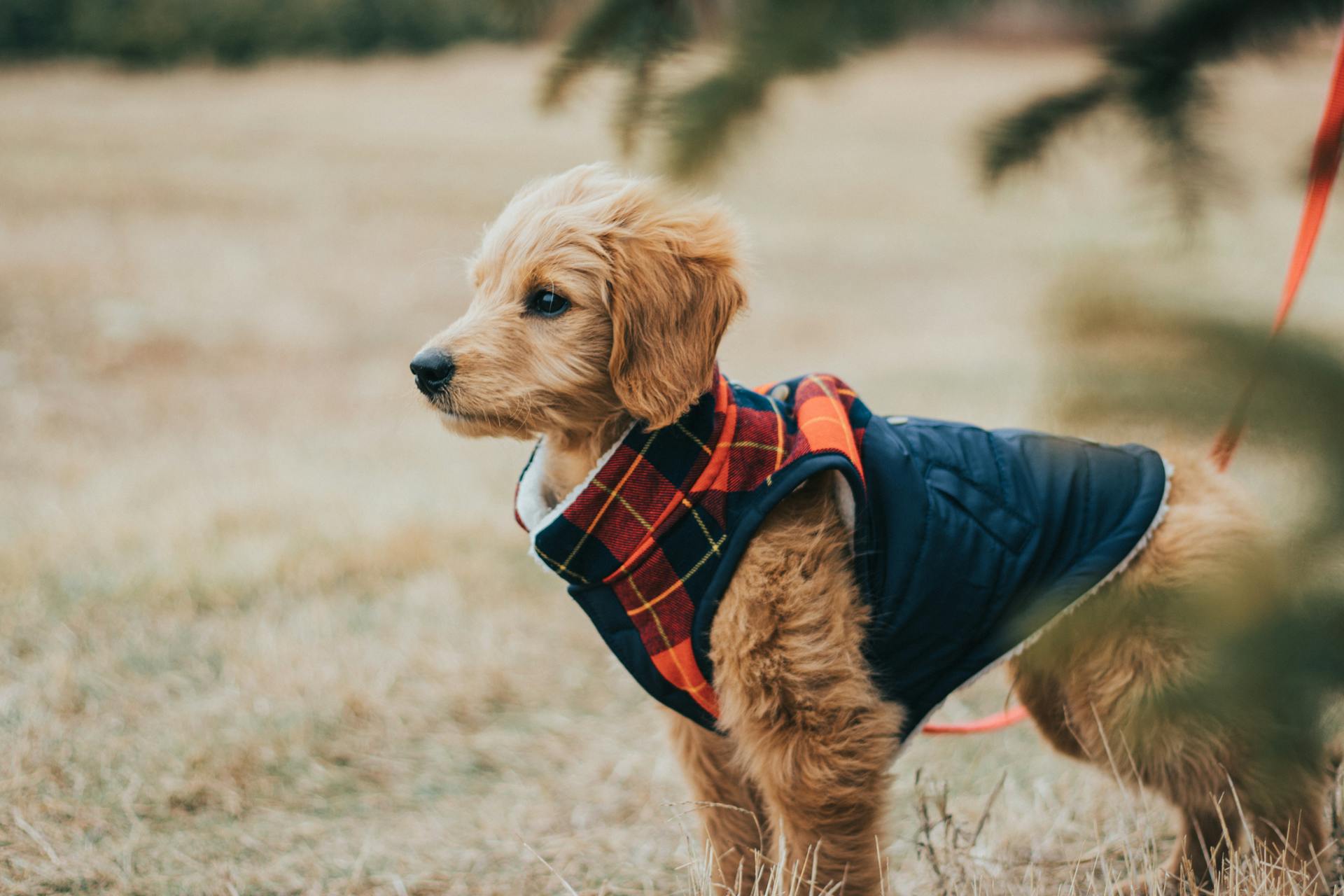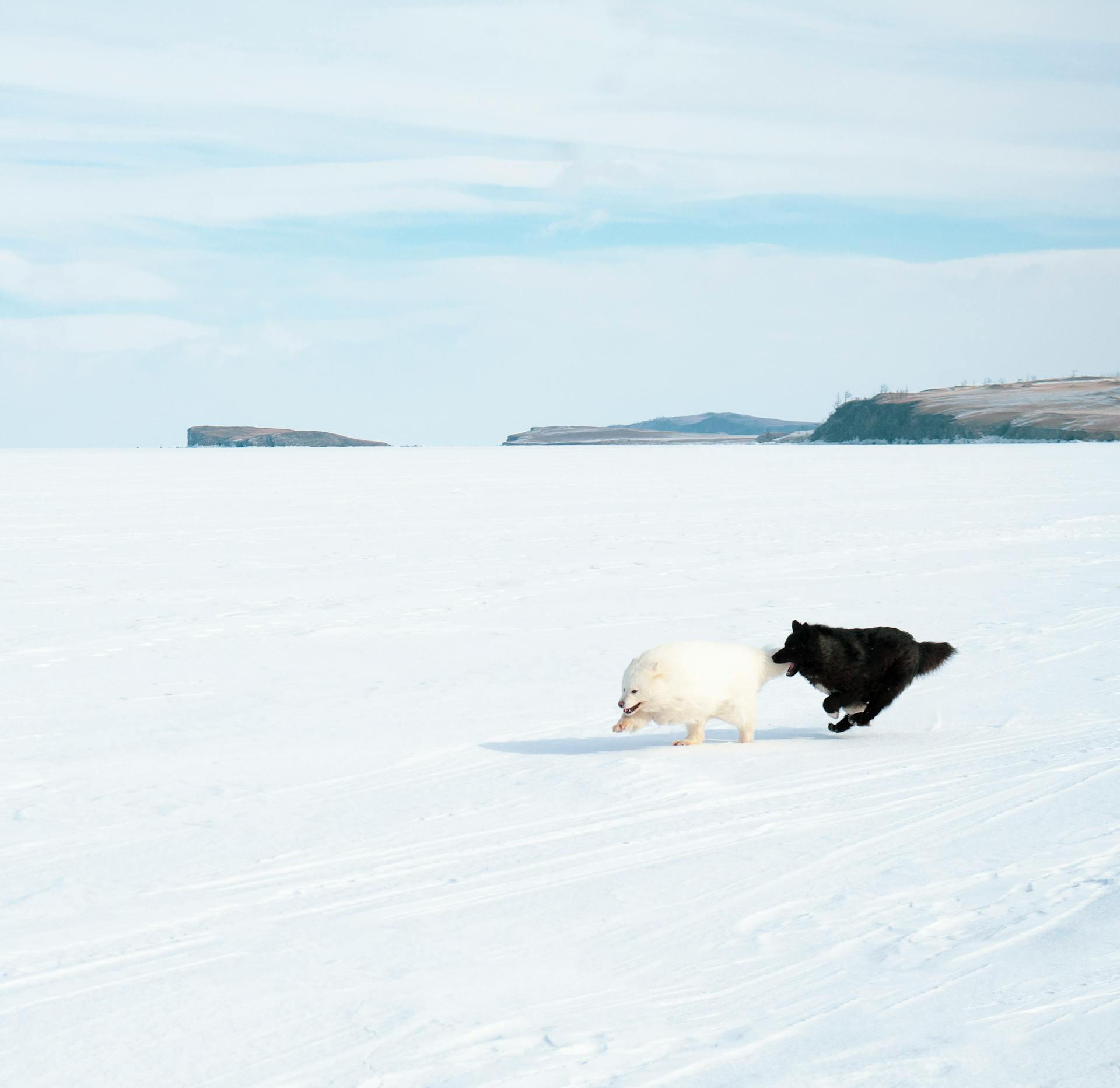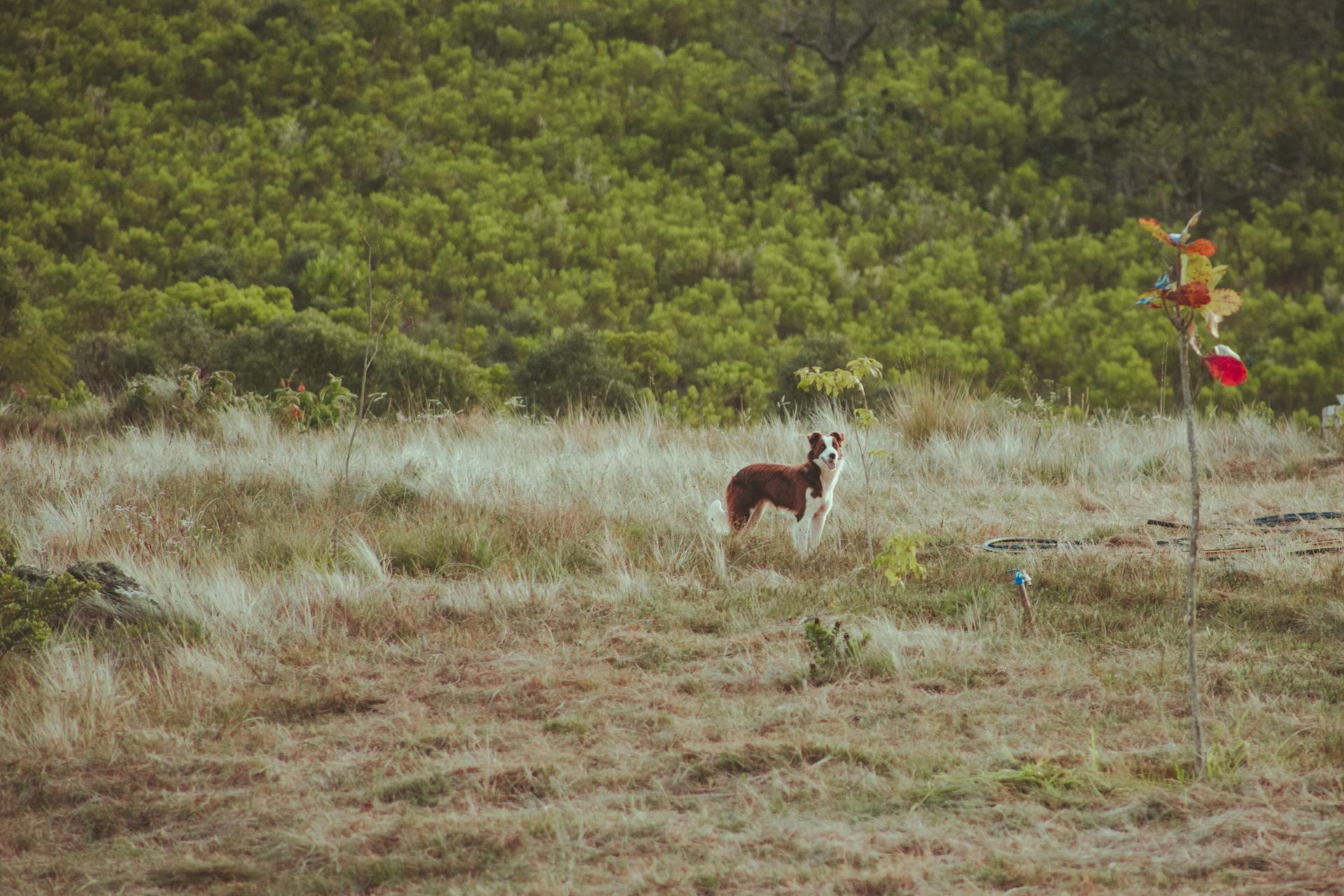
Domestic dog classes are a way to categorize dogs based on their physical characteristics and traits. They can be divided into seven groups: Sporting, Hound, Working, Terrier, Toy, Non-Sporting, and Herding.
The Sporting group includes breeds that were originally bred for hunting and retrieving game. Examples of these breeds include the Labrador Retriever and the Golden Retriever.
Dogs in the Sporting group are often energetic and love to play fetch. Their short coats require regular grooming to prevent matting.
The Hound group consists of breeds that were bred for hunting small game, such as rabbits and hares. They are known for their keen sense of smell and strong instincts.
Worth a look: Best Food for Hunting Dogs
Domestication and Classification
The domestic dog class is a fascinating topic that has been studied extensively by scientists. The earliest remains of a domesticated dog were discovered in Bonn-Oberkassel, Germany, and dated back to 14,223 years ago.
These ancient dogs were buried with humans and had been sprayed with red hematite powder, indicating a deep connection between humans and dogs. The dog that was found had died of canine distemper.
Genetic studies suggest that all living dogs share a common ancestry and descended from an ancient, extinct wolf population. This means that dogs are closely related to wolves, but have undergone significant changes through domestication.
The process of domestication is believed to have occurred over 25,000 years ago, with some studies suggesting that it may have started in Siberia. The domestic dog is classified as a subspecies of Canis lupus, which includes wolves and dingoes.
Here's a breakdown of the dog's classification:
- Kingdom: Animalia
- Phylum: Chordata
- Class: Mammalia
- Order: Carnivora
- Family: Canidae
- Genus: Canis
- Species: lupus
- Subspecies: familiaris
This classification reflects the dog's close relationship to wolves and its unique characteristics as a domesticated species.
Physical Characteristics
Dogs can vary greatly in size, ranging from the tiny Chihuahua to the massive Great Dane.
Some dogs have naturally short tails, with as few as three vertebrae, while others have the standard 26.
Dogs have a well-adapted skeleton for running, with vertebrae that allow for flexibility and long ribs that provide room for their heart and lungs.
Size and Skeleton
Dogs come in a wide range of sizes, from the tiny Chihuahua to the massive Great Dane.
The Great Dane can weigh between 110 to 174 pounds and stand between 28 to 32 inches tall, while the Chihuahua weighs between 1.1 to 6.6 pounds and stands between 5.1 to 7.9 inches tall.
All healthy dogs, regardless of their size, have the same number of bones, with the exception of the tail.
The dog's skeleton is well adapted for running, with vertebrae on the neck and back designed to connect to powerful back muscles.
The long ribs in dogs provide room for the heart and lungs, and the shoulders are unattached to the skeleton, allowing for flexibility in movement.
Dogs have evolved from wolf-like ancestors, and selective breeding has led to significant changes in their skeletons, with larger breeds having larger skeletons and smaller breeds having smaller skeletons.
Some breeds, such as dachshunds and corgis, have been selectively bred for short legs due to dwarfism, while others, such as mastiffs, have been bred for larger skeletons.
A unique perspective: Domestic Dog Breeds
Coat
Dogs can have two types of coats: double or single. A double coat is common in many breeds and consists of a coarse guard hair and a soft down hair.
The double coat helps dogs stay warm in colder climates. Some breeds have a very thick corded coat, which can be a lot of work to maintain.
Premature graying can occur in dogs as early as one year of age. This is often associated with impulsive behaviors, anxiety behaviors, and fear of unfamiliar noise, people, or animals.
Some dog breeds are hairless, while others have thick coats that require regular grooming. The coats of certain breeds are often groomed to a specific style, such as the Yorkshire Terrier's "show cut".
Readers also liked: Dog Breeds Watch Dogs
Tail
A dog's tail is the terminal appendage of the vertebral column, made up of a string of 5 to 23 vertebrae enclosed in muscles and skin that support the dog's back extensor muscles.
The primary function of a dog's tail is to communicate their emotional state, and it can also help the dog maintain balance by putting its weight on the opposite side of the dog's tilt.
Dogs can have a violet gland, characterized by sebaceous glands on the dorsal surface of their tails, which can be affected by conditions like Cushing's disease or an excess of sebum from androgens in the sebaceous glands.
Dogs show asymmetric tail-wagging responses to different emotive stimuli, with a higher amplitude of tail-wagging movements to the right side in response to stimuli that elicit approach tendencies.
Some dogs can injure themselves by wagging their tails forcefully, a condition known as kennel tail, happy tail, bleeding tail, or splitting tail.
Senses and Behavior
Dogs have a unique way of perceiving the world around them, thanks to their incredible senses. Their vision is dichromatic, meaning they see yellows, blues, and grays, but struggle to differentiate between red and green.
Dogs' sense of smell is truly remarkable, with some breeds having up to 300 million smell-sensitive receptors. This allows them to pinpoint the location of food, potential threats, and even their favorite toys with ease.
Their acute sense of hearing is also impressive, with some studies suggesting it's up to 4 times greater than that of humans. This means they can pick up on even the faintest sounds from a distance, making them alert to potential dangers or interesting stimuli.
Senses
Dogs' sense of smell is incredibly powerful, with some breeds having up to 300 million smell-sensitive receptors. This allows them to detect chemical changes in their environment.
Dogs can pinpoint the location of mating partners, potential stressors, and resources using their sense of smell. Their sense of smell is the most prominent sense of the species.
Their acute sense of hearing is up to 4 times greater than that of humans, allowing them to pick up the slightest sounds from about 400 meters away.
Dogs can detect vibrations and objects not visible in low light conditions with their stiff, deeply embedded hairs known as whiskers. These whiskers are embedded in the face and help alert dogs of objects that could collide with the nose, ears, and jaw.
Dogs have difficulty differentiating between red and green due to their dichromatic vision. Their visual world consists of yellows, blues, and grays.
Their visual acuity is up to 8 times less effective than a human's, and their ability to discriminate levels of brightness is about two times worse than a human's.
Intelligence
Dogs can learn by inference, which means they can figure out new things by using what they already know. A study with Rico, a Border Collie, showed that he could learn the labels of over 200 different items and even infer the names of novel things after four weeks of exposure.
Dogs have impressive memory capabilities, but not all of them have spatial memory. A study found that 18 household dogs couldn't distinguish food bowls at specific locations without distinguishing cues.
Some dogs have a visual sense for number, which means they can understand quantities. A study showed that dogs showed a ratio-dependent activation both for numerical values from 1-3 to larger than four.
Dogs demonstrate a theory of mind by engaging in deception, which means they can understand that others have thoughts and feelings. They can even fake it to get what they want.
Australian dingos have been shown to outperform domestic dogs in non-social problem-solving, indicating that domestic dogs may have lost some of their original problem-solving abilities.
Health and Reproduction
Sexual maturity in domestic dogs happens around six months to one year for both males and females, although this can be delayed until up to two years of age for some large breeds.
Female dogs will have their first estrous cycle around six months to one year, characterized by their vulvas swelling and producing discharges, usually lasting between 4 and 20 days.
The estrous cycle typically lasts between 4 and 20 days, after which the female dog will experience a period of receptivity to copulation. This cycle repeats semiannually, preparing the body for pregnancy.
Discover more: Dog Mate Female Dog
Reproduction

Reproduction is a fascinating process in dogs, and understanding it can help you care for your furry friend.
Female dogs typically reach sexual maturity between six months to one year of age, although some large breeds may take up to two years to mature.
The estrous cycle in female dogs usually lasts between 4 and 20 days, during which their vulvas will swell and produce discharges.
Fertilization typically occurs two to five days after ovulation, and because the ova can survive for a week, more than one male can sire the same litter.
After ejaculation, dogs are coitally tied for around 5–30 minutes due to the male's bulbus glandis swelling and the female's constrictor vestibuli contracting.
A litter of puppies can consist of around six puppies on average, but this number can vary.
Dogs typically bear their litters roughly 58 to 68 days after fertilization, with an average of 63 days.
Health Benefits
Having a dog can have a significant impact on our physical and mental health. Studies suggest that dog owners make fewer hospital visits and are less likely to be on medication for heart problems and sleeping difficulties than non-owners.

People with pet dogs take considerably more physical exercise than those with cats or those without pets, and these effects are relatively long-term. This is likely due to the fact that dog owners need to take their pets for walks and exercise.
Having a dog can also increase our social connections. One study found that wheelchair-users experience more positive social interactions with strangers when accompanied by a dog.
Pet guardianship has been associated with increased survival in cases of coronary artery disease, with human guardians being significantly less likely to die within one year of an acute myocardial infarction than those who do not own dogs.
Studies have found a small to moderate correlation between dog-ownership and increased adult physical-activity levels. This is likely one of the reasons why dog owners tend to be healthier than non-owners.
Lifespan and Cultural Significance
The lifespan of dogs varies widely among breeds, but the median longevity is approximately 12.7 years. Obesity can reduce a dog's life expectancy by about a year and a half.
In a 2024 UK study, purebred dogs were found to live longer than crossbred dogs, challenging the previous notion that crossbred dogs have higher life expectancies. However, other studies show that fully mongrel dogs live about a year longer on average than dogs with pedigrees.
Dogs have been imbued with cultural significance across various societies, often symbolizing guidance, protection, loyalty, fidelity, and love. In ancient Mesopotamia, dogs were associated with the goddess of healing and medicine, and in China, Korea, and Japan, they are viewed as kind protectors.
Here's a breakdown of the median life expectancy for different dog groups:
In many cultures, dogs are revered for their loyalty and faithfulness, with some even being associated with deities or serving as emblems of magical protection.
Lifespan
Dogs' lifespans vary greatly depending on their breed, with a median longevity of approximately 12.7 years.
Obesity has a significant impact on a dog's lifespan, with obese dogs having a life expectancy about a year and a half less than their healthy-weight counterparts.

In fact, a 2024 UK study found that purebred dogs lived longer than crossbred dogs, challenging the previous notion that crossbred dogs have higher life expectancies.
Small dogs with longer muzzles tend to live longer than larger medium-sized dogs with shorter muzzles.
Feral dogs, on the other hand, have a much shorter lifespan, with less than 1 in 5 reaching sexual maturity and a median life expectancy of less than half that of dogs living with humans.
Cultural Importance
Dogs have been revered as symbols of guidance, protection, loyalty, fidelity, faithfulness, alertness, and love in various cultures.
In ancient Mesopotamia, dogs were the symbol of Ninisina, the goddess of healing and medicine, and her worshippers frequently dedicated small models of seated dogs to her.
Dogs have also been associated with magical protection in the Neo-Assyrian and Neo-Babylonian periods.
In China, Korea, and Japan, dogs are viewed as kind protectors.
In many mythologies, dogs appear as pets or watchdogs, guarding the gates of the underworld, such as in Greek mythology where Cerberus is a three-headed, dragon-tailed watchdog who guards the gates of Hades.

Here are some examples of dogs in mythology:
In Christianity, dogs represent faithfulness, and Saint Dominic's iconography includes a dog, reflecting the importance of dogs in the faith.
In Jewish law, dogs are not prohibited, and Jews are required to feed them before themselves.
The view on dogs in Islam is mixed, but some schools of thought view them as unclean, although this view is disputed.
Breeds and Genetics
The domestic dog class has over 340 recognized breeds, each with its unique characteristics and traits.
The genetic diversity of domestic dogs is influenced by their origins as a hybrid species, resulting from the cross between gray wolves and other prehistoric canine species.
Some breeds, like the Poodle, have a low-shedding coat due to a genetic mutation that affects the production of a specific protein.
A different take: Dog Breeds That Are Good with Other Dogs
Inbreeding Depression
Inbreeding depression is a serious issue in dog breeding. In a study of seven dog breeds, inbreeding was found to decrease litter size and survival.
Mating close relatives, such as half- and full-siblings, is a common breeding practice that can lead to inbreeding depression. This can result in smaller litters and a higher risk of stillbirth.
A study of 42,855 Dachshund litters found that as the inbreeding coefficient increased, litter size decreased and the percentage of stillborn puppies increased. This indicates that inbreeding depression is a real concern in this breed.
In some cases, inbreeding depression can be fatal. In a study of Boxer litters, 22% of puppies died before reaching 7 weeks of age, with stillbirth being the most frequent cause of death.
Breeds
There are around 450 official dog breeds, the most of any mammal.
Most breeds were derived from small numbers of founders within the last 200 years.
Dogs have undergone rapid phenotypic change and have been subjected to artificial selection by humans.
The skull, body, and limb proportions between breeds display more phenotypic diversity than can be found within the entire order of carnivores.
Dogs possess distinct traits related to morphology, including body size, skull shape, tail phenotype, fur type, and colour.
These traits have been used by humans to complete or fulfill a certain work or role.
Present-day dogs are dispersed around the world, with numerous modern breeds of European lineage dating back to the Victorian era.
Frequently Asked Questions
What is the order of domestic dogs?
Domestic dogs belong to the order Carnivora. This order includes mammals that primarily eat meat, such as dogs, cats, and weasels.
Which of these is the class that the domestic dog belongs to?
The domestic dog belongs to the class Mammalia. This classification is part of the broader phylum Chordata.
Featured Images: pexels.com


